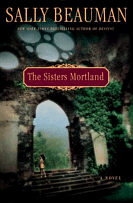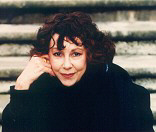Searching for the Sisters
by Sally Beauman
It's always so hard to say where novels begin -- it's a ghostly process, I find. When I started writing The Sisters Mortland, I knew that it would be about stories, the truths and lies they contain. I knew it had to be set in the depths of the English countryside, and I knew the county I wanted to use was Suffolk, still deeply rural in many parts, with a strong farming tradition -- I wanted a place that has grown properous, but been ravaged by farming practices in the post-war years. It isn't an area of England I know that well -- I've visited it often, but never lived there. That was a plus: I don't like to write about people or places I already know -- I like them to be foreign, so as I actually write they have to be found.

|
I also knew it would be a novel that centred on three sisters -- two of them young women and one a child when the book opens -- and one summer in the life of the sisters, a summer when the portrait that gives the novel its title is being painted by a Cambridge friend. I knew something terrible, an appalling event, would happen in that idyllic summer of 1967 and I knew I wanted to investigate the ways in which such events stain, distort and influence the lives of all concerned.
I knew too that it must be a novel of contingencies, where nothing is certain, and where solutions are withheld -- and for that reason I decided to use three different narrators, each of whom approaches these events from a different viewpoint, over a span of twenty years. I wanted it to be a novel of voices, each commenting on and contradicting one another --- and to make it work, for the machinery to spin and grind, those voices had to be as familiar to me as my own.
Maisie, who begins the novel is an outsider, a strange prescient thirteen-year-old child - a little girl who talks to the dead, but a girl with a tough, ascerbic mind. Maisie lures the reader in -- I intended a lure -- to what may seem at first another assay at a familiar form, the English country house novel -- a genre with a long tradition, Mansfield Park being at one end of it, and Ian McEwan's Atonement at the other. Maisie's story, her account of that summer, of her family, of the strange house in which they live (it's a medieval Abbey, a former nunnery) and of the portrait an artist friend is painting forms the first part of the novel. She describes her two sisters, clever, evasive Finn and beautiful self-centred Julia, and she struggles to understand the young men staying at the house who are irresistably drawn to them. But I wanted the reader to see gaps; I wanted readers to decide whether the persuasive Maisie was telling the truth. Like Lucas, Maisie is also painting a portrait of three sisters -- but what does she reveal, and conceal?
Then the novel takes a a sudden unpredictable turn. It breaks with the conventions it seemed to be following, it hurtles off-piste -- there's a substantial time-jump, and I introduce a second voice, that of a man, Daniel Nunn. Dan, a friend of the sisters since early childhood, and worshipped by Maisie, has grown up in the same village but in very different circumstances. He is of Romany descent; his father is a farm labourer, and his grandmother, who brought him up, and claims to have second sight, works at the Abbey as a cleaner -- but Dan, who has won a scholarship to Cambridge, is on the cusp of change, about to abandon his home, his family and his class.
Dan is self-destructive, anarchic, gifted and (I hope) funny -- I wanted black humour, wanted readers to hate him, then maybe forgive him when they turn the page. Dan embarks on a quest, determined to understand the appalling events that happened at the Abbey in the summer of 1967 -- but he's hampered by several factors. He's writing more than twenty years later; he's drinking too much, he's lost his high-powered job, he's lost the woman he loved, he's riddled with guilt, and overpowered by a sense of failure -- plus, like most of us, he's been used to glossing over his past. So confronting it, trying to understand it is a very harsh task.
Finally, Julia, the eldest, coolest, most beautiful, most successful and apparently the least likeable of the three sisters takes up the narrative. She weaves the final patterns of the story of the Abbey, of Maisie and Dan, and I hope those weavings will surprise some readers -- but does Julia give closure? In a sense, perhaps, but I distrust closure, and I certainly distrust easy answers. And this is a novel about love -- love of place, of family, of children, as well as love between men and women and all the lies and self deceptions that such loves entail. So at the end of the novel, as one might expect, questions remain.
 **Sally Beauman's novels have been translated into more than twenty
languages and have been bestsellers worldwide. She has written for numerous
magazines in both the United States and England, including
The New Yorker and The Daily Telegraph. She lives with her family in London
and on an island in the Hebrides. Her latest novel is
The Sisters Mortland,
a story about three sisters and the tragedy that becomes the center of their lives.
**Sally Beauman's novels have been translated into more than twenty
languages and have been bestsellers worldwide. She has written for numerous
magazines in both the United States and England, including
The New Yorker and The Daily Telegraph. She lives with her family in London
and on an island in the Hebrides. Her latest novel is
The Sisters Mortland,
a story about three sisters and the tragedy that becomes the center of their lives.
Return to the February 2006 issue of The IWJ.
